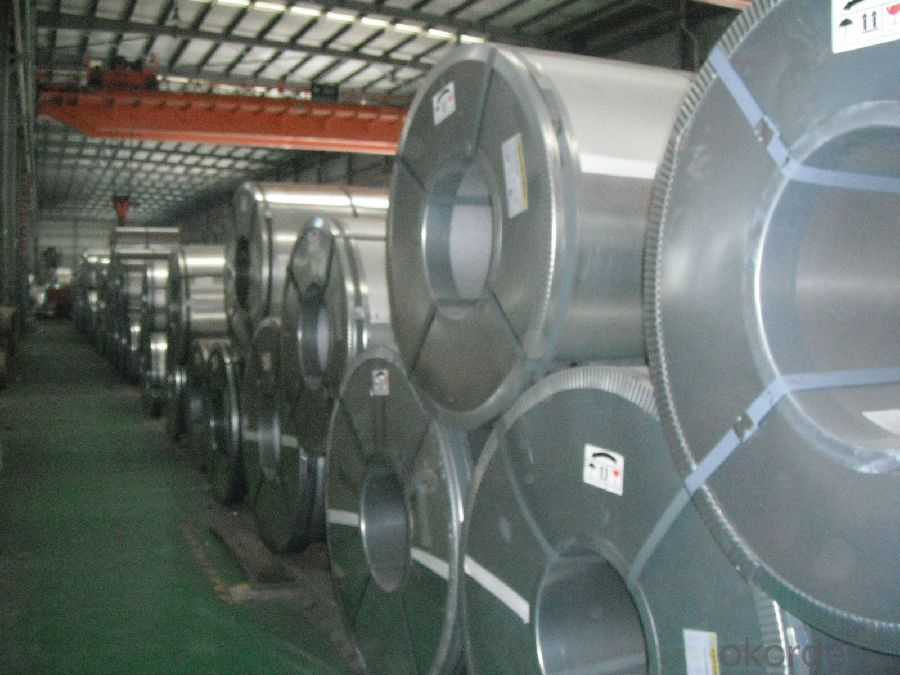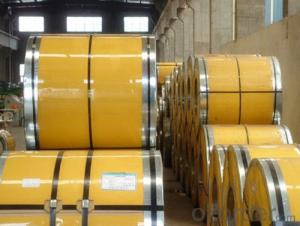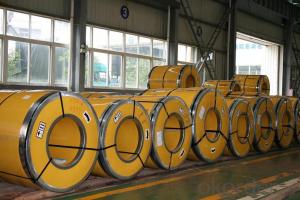Hot Rolled Stailess Steel Coils 400 Serious
- Loading Port:
- Shanghai
- Payment Terms:
- TT OR LC
- Min Order Qty:
- 25 m.t.
- Supply Capability:
- 100000 m.t./month
OKorder Service Pledge
OKorder Financial Service
You Might Also Like
Hot Rolled Stailess Steel Coils 400 Serious
1.Structure of Hot Rolled Stailess Steel Coils 400 Serious
Hot Rolled Stailess Steel Coils 400 Serious is one of the raw material of the cold rolled stainless steel strip, which can be used directly in many places. Stainless Steel (Stainless Steel) is short for acid-proof Stainless Steel, resistant to weak corrosive medium such as air, steam, water, or with a Stainless Steel grade.
2.Main Features of Hot Rolled Stailess Steel Coils 400 Serious
1) weldability: The purpose of the different requirement for welding performance are different.1 Kind of tableware generally do not require the performance of welding, even including some pot class enterprise. But the vast majority of products all need raw materials welding performance is good, like the 2 kinds of tableware, thermos flask, steel pipes, water heaters, water dispensers, etc.
2) Corrosion resistance The vast majority of stainless steel products for corrosion resistant performance is good, like a, 2 kinds of tableware, kitchen utensils and appliances, water heaters, water dispensers, etc., some foreign businessmen on corrosion resistance of products also do experiment: in NACL aqueous solution heated to boiling, after a period of time the best solution, wash and drying, weight loss, to determine the degree of corrosion (note: the product polishing, because of the sand cloth or sandpaper containing Fe, will cause the test surface rust spots)
3) Polishing performance In today's society stainless steel products in production after polishing the process commonly, when only a small number of products such as water heaters, water dispenser tank don't need polishing. So this will require materials polishing performance is very good. The factors influencing polishing performance mainly include the following: 1) raw material surface defects. Such as scratch, pitting, pickling, etc. (2) raw material problem. Hardness is too low, easy when polishing cast light (BQ), and the hardness is too low, the surface easily when deep drawing appear orange peel phenomenon, which affects the BQ. Relatively high hardness of BQ sex is good. (3) after deep drawing products, great deformation area surface will be a small black spots and RIDGING, thus affecting the BQ.
4) Heat resistant performance Heat resistant performance refers to the high temperature stainless steel can still maintain its excellent physical and mechanical properties. Carbon: the influence of carbon in austenitic stainless steel is formed strong and steady. Set the austenitic austenitic area and expand elements. Carbon formation of austenite is about 30 times that of the nickel, the ability of carbon is a kind of gap elements, through the solid solution strengthening can significantly increase the strength of the austenitic stainless steel. Carbon austenitic stainless steel can be improved in high concentration chloride (e.g., 42% MgCl2 boiling solution) in the performance of the resistance to stress corrosion. But, in the austenitic stainless steel, carbon is often seen as the harmful elements, this is mainly due to the corrosion of stainless steel used in some conditions, such as welding or heating by 450 ~ 850 ℃), carbon steel with chromium in forming high chromium Cr23C6 type carbon compounds which can lead to local chromium depletion, make steel corrosion resistance especially resistant to intergranular corrosion performance degradation. So. Since the 60 s of the development of new cr-ni austenitic stainless steel is mostly carbon content less than 0.03% or 0.02% of the ultra-low carbon type
5) Corrosion resistance When the atomic number of no less than 12.5% chromium content in steel, can make the steel electrode potential mutations, the negative potential to the positive electrode potential. To prevent electrochemical corrosion.
3. Hot Rolled Stailess Steel Coils 400 Serious Images


4. Hot Rolled Stailess Steel Coils 400 Serious Specification
The word "stainless steel" is not merely refers to a pure stainless steel, but said more than one hundred kinds of stainless steel industry, the development of each stainless steel has good performance in their specific applications. The key to the success of the first is to make clear purpose, and then determine the correct material. Related to architectural construction applications usually only six types of steel. They contain 17 ~ 22% chromium, good steel contains nickel. Add molybdenum can further improve the atmospheric corrosion resistance, especially containing chloride atmospheric corrosion resistance. Stainless steel often according to the state of organization can be divided into: martensite steel, ferritic steel, austenitic steel, austenitic (two-phase) - ferrite stainless steel and precipitation hardening stainless steel, etc. In addition, according to ingredients can be divided into: chromium stainless steel, chromium nickel stainless steel and chromium manganese nitrogen stainless steel, etc.
1) Ferritic stainless steel Chromium containing 15% ~ 30%. Its corrosion resistance, toughness and weldability with chromium content increases with the increase of chloride stress corrosion resistance is superior to other types of stainless steel, fall into this category of Crl7, Cr17Mo2Ti, Cr25, Cr25Mo3Ti, Cr28, etc. Ferritic stainless steel because of the high chromium content, corrosion resistance and oxidation resistance are relatively good, but the mechanical properties and process performance is poorer, more used to stress less acid structure and steel used as antioxidant. This kind of steel to withstand atmosphere, nitric acid and corrosion of the brine solution, and has good high temperature oxidation resistance, low thermal expansion coefficient, etc, used in nitric acid and food factory equipment, also can make work under high temperature parts, such as gas turbine parts, etc.
2) Austenitic stainless steel The title Chromium is more than 18%, still contain about 8% of the nickel and small amounts of molybdenum, titanium, nitrogen and other elements. Good comprehensive performance, corrosion resistant to a variety of media. Number of austenitic stainless steel is commonly used one cr18ni9, 0 cr19ni9, etc. In the Wc < 0.08% 0 cr19ni9 steel, steel grade is marked as "0". This class contains large amounts of Ni and Cr in steel, make steel in austenitic state at room temperature. This kind of steel has good plasticity and toughness, weldability and corrosion resistance and non-magnetic or weak magnetic, the corrosion resistance in oxidizing and reducing medium are good, used to make acid equipment, such as corrosion resistant containers and equipment lining, pipelines, nitric acid resistant equipment parts, etc., also can be used as the main body of watches and clocks jewelry stainless steel material. Austenitic stainless steel with solid solution treatment, the steel heating to 1050 ~ 1150 ℃, then water-cooled or air-cooled, for single-phase austenitic organization.
3) Austenitic, ferritic duplex stainless steel The advantages of both austenitic and ferritic stainless steel, and has the superplasticity. Austenite and ferrite The title Each accounts for about half of the stainless steel. In the case of contain low C, Cr content was 18% ~ 18%, Ni content at 3% ~ 3%. Some steel containing Mo, Cu, Si, Nb, Ti, N and other alloying elements. This kind of steel both austenite and ferrite stainless steel, the characteristics of compared with ferrite, plasticity and toughness is higher, no room temperature brittleness, intergranular corrosion resistance and welding performance were significantly increased, while maintaining a ferritic stainless steel of 475 ℃ brittleness and high thermal conductivity, has the characteristics of superplasticity. Compared with austenitic stainless steel, high strength and resistance to intergranular corrosion and resistance to chloride stress corrosion is improved obviously. Duplex stainless steel has excellent resistance to pitting corrosion performance, is also a kind of nickel and stainless steel.
4) Precipitation hardening stainless steel For austenitic or martensite structure matrix, and the number of precipitation hardening stainless steel commonly used such as 04 cr13ni8mo2al. It can pass the precipitation hardening (also known as the age hardening) dealing with the hard (strong) of stainless steel.
5) Precipitation hardening stainless steel For austenitic or martensite structure matrix, and the number of precipitation hardening stainless steel commonly used such as 04 cr13ni8mo2al. It can pass the precipitation hardening (also known as the age hardening) dealing with the hard (strong) of stainless steel.
5.FAQ of Hot Rolled Stailess Steel Coils 400 Serious
We have organized several common questions for our clients,may help you sincerely:
①How about your company?
A world class manufacturer & supplier of castings forging in carbon steel and alloy steel,is one of the large-scale professional investment casting production bases in China,consisting of both casting foundry forging and machining factory. Annually more than 8000 tons Precision casting and forging parts are exported to markets in Europe,
②How to guarantee the quality of the products?
We have established the international advanced quality management system,every link from raw material to final product we have strict quality test;We resolutely put an end to unqualified products flowing into the market. At the same time, we will provide necessary follow-up service assurance.
③How to get the best quotation?
You can send us your detail inquiry including the specification and quantity.
.
- Q:Can 111 stainless steel strips be formed into complex shapes?
- Complex shapes can indeed be formed using 111 stainless steel strips. Stainless steel is renowned for its exceptional formability and versatility. It possesses the remarkable ability to be easily manipulated, bent, and shaped into a wide range of intricate geometries. The quantity of strips, specifically 111 in this instance, does not impose any limitations on the creation of complex shapes. Depending on the desired final form, the process of transforming stainless steel strips into intricate shapes may involve a variety of techniques, including bending, rolling, stamping, or welding. By employing the appropriate tools, expertise, and methodologies, stainless steel strips can be effectively fashioned into elaborate and multifaceted shapes, catering to diverse applications across industries such as architecture, automotive, aerospace, and beyond.
- Q:What is the difference between cold rolled and hot rolled stainless steel strips?
- The manufacturing processes and resulting properties of cold rolled and hot rolled stainless steel strips are different. To produce cold rolled stainless steel strips, the stainless steel is passed through a series of rollers at room temperature. This process creates a thinner and more precise strip with a smooth and shiny surface finish. Additionally, cold rolling strengthens and hardens the stainless steel, making it suitable for applications that require high strength and a polished appearance. Furthermore, cold rolled stainless steel strips have better dimensional accuracy and straightness compared to hot rolled strips. On the contrary, hot rolled stainless steel strips are manufactured by heating the stainless steel slab or billet to a high temperature and then rolling it through a series of rolling mills. This process results in a thicker and less precise strip with a rough and scaled surface finish. Hot rolling is preferred for applications that do not require a high level of precision or a polished appearance, such as structural applications or manufacturing processes that involve further shaping or forming of the stainless steel strip. Regarding properties, cold rolled stainless steel strips have higher tensile strength and yield strength than hot rolled strips. They also exhibit better corrosion resistance, as the cold rolling process refines the microstructure, reducing the presence of defects and impurities. However, hot rolled stainless steel strips have higher ductility and are more easily formable due to the higher temperature processing. In conclusion, the choice between cold rolled and hot rolled stainless steel strips depends on specific application requirements, such as the desired surface finish, dimensional accuracy, strength, and formability.
- Q:Can stainless steel strips be used in architectural staircase systems?
- Indeed, architectural staircase systems can incorporate stainless steel strips. The durability, corrosion resistance, and aesthetic appeal of stainless steel make it a popular choice for stairs. The utilization of stainless steel strips within the staircase system is versatile, as they can serve as treads, risers, handrails, balusters, or decorative elements. The customization of these strips to meet specific design needs enables flexibility and creativity in staircase design. Furthermore, various finishes, such as brushed or polished, can be applied to the stainless steel strips to achieve the desired appearance and texture of the staircase.
- Q:How do stainless steel strips resist stress corrosion cracking?
- Stainless steel strips resist stress corrosion cracking due to their high levels of chromium, which forms a protective oxide layer on the surface. This oxide layer acts as a barrier, preventing the corrosive environment from reaching the underlying metal and causing cracking.
- Q:Are stainless steel strips suitable for pharmaceutical equipment?
- Yes, stainless steel strips are suitable for pharmaceutical equipment. Stainless steel is highly resistant to corrosion, easy to clean, and has excellent durability, making it an ideal material for pharmaceutical equipment that requires high levels of cleanliness and hygiene. Additionally, stainless steel is non-reactive with most chemicals, ensuring the integrity and safety of pharmaceutical products.
- Q:Can stainless steel strips be used for architectural canopies?
- Yes, stainless steel strips can be used for architectural canopies. Stainless steel is known for its durability, strength, and resistance to corrosion, making it a popular choice for architectural applications. The strips can be shaped and fabricated to create unique and visually appealing canopies that offer protection from the elements while maintaining a sleek and modern aesthetic.
- Q:Which material is better, stainless steel or belt?
- Summer is the best with a stainless steel belt, the belt in the summer after the sweat corrosion, there will be an unpleasant smell, easily broken; stainless steel material is relatively good, generally not bad, summer with sweat also nothing, no taste. I hope my answer will be helpful to you!
- Q:What is the price range for stainless steel strips?
- The price range for stainless steel strips can vary depending on factors such as thickness, width, grade, and quantity. Generally, stainless steel strips can range anywhere from $1 to $10 per pound or more.
- Q:The difference between stainless steel and cold rolled steel strip
- It: cold rolled steel strength is very high, but the toughness and weldability is poor, hard, crisp, bright surface
- Q:Can stainless steel strips be used in household appliances?
- Household appliances can indeed utilize stainless steel strips. The exceptional resistance to corrosion, durability, and appealing appearance make stainless steel a popular choice in appliance manufacturing. It is common to find stainless steel strips incorporated into different parts of household appliances like refrigerators, dishwashers, ovens, and stovetops. These strips often contribute to the construction of appliance doors, handles, control panels, and trims. By employing stainless steel strips, appliances acquire a contemporary and polished appearance while also possessing the necessary strength and resilience to endure the rigors of daily use in a household environment.
1. Manufacturer Overview |
|
|---|---|
| Location | |
| Year Established | |
| Annual Output Value | |
| Main Markets | |
| Company Certifications | |
2. Manufacturer Certificates |
|
|---|---|
| a) Certification Name | |
| Range | |
| Reference | |
| Validity Period | |
3. Manufacturer Capability |
|
|---|---|
| a)Trade Capacity | |
| Nearest Port | |
| Export Percentage | |
| No.of Employees in Trade Department | |
| Language Spoken: | |
| b)Factory Information | |
| Factory Size: | |
| No. of Production Lines | |
| Contract Manufacturing | |
| Product Price Range | |
Send your message to us
Hot Rolled Stailess Steel Coils 400 Serious
- Loading Port:
- Shanghai
- Payment Terms:
- TT OR LC
- Min Order Qty:
- 25 m.t.
- Supply Capability:
- 100000 m.t./month
OKorder Service Pledge
OKorder Financial Service
Similar products
New products
Hot products
Related keywords





























